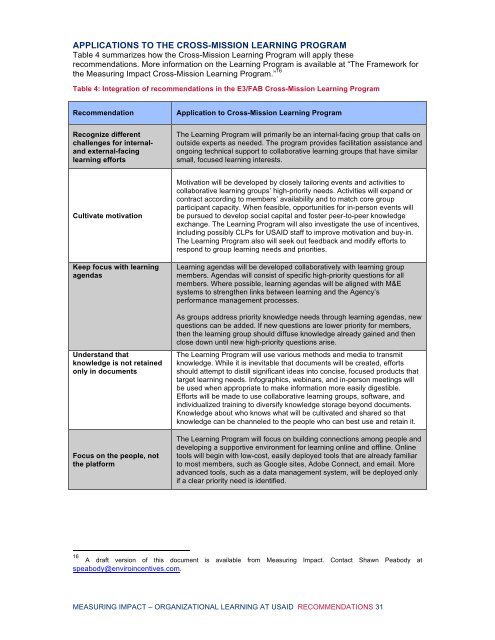MEASURING IMPACT Making Use of the Portfolio Organizational Learning at USAID
28Mzh2D
28Mzh2D
You also want an ePaper? Increase the reach of your titles
YUMPU automatically turns print PDFs into web optimized ePapers that Google loves.
APPLICATIONS TO THE CROSS-MISSION LEARNING PROGRAM<br />
Table 4 summarizes how <strong>the</strong> Cross-Mission <strong>Learning</strong> Program will apply <strong>the</strong>se<br />
recommend<strong>at</strong>ions. More inform<strong>at</strong>ion on <strong>the</strong> <strong>Learning</strong> Program is available <strong>at</strong> “The Framework for<br />
<strong>the</strong> Measuring Impact Cross-Mission <strong>Learning</strong> Program.” 16<br />
Table 4: Integr<strong>at</strong>ion <strong>of</strong> recommend<strong>at</strong>ions in <strong>the</strong> E3/FAB Cross-Mission <strong>Learning</strong> Program<br />
Recommend<strong>at</strong>ion<br />
Applic<strong>at</strong>ion to Cross-Mission <strong>Learning</strong> Program<br />
Recognize different<br />
challenges for internaland<br />
external-facing<br />
learning efforts<br />
The <strong>Learning</strong> Program will primarily be an internal-facing group th<strong>at</strong> calls on<br />
outside experts as needed. The program provides facilit<strong>at</strong>ion assistance and<br />
ongoing technical support to collabor<strong>at</strong>ive learning groups th<strong>at</strong> have similar<br />
small, focused learning interests.<br />
Cultiv<strong>at</strong>e motiv<strong>at</strong>ion<br />
Keep focus with learning<br />
agendas<br />
Understand th<strong>at</strong><br />
knowledge is not retained<br />
only in documents<br />
Focus on <strong>the</strong> people, not<br />
<strong>the</strong> pl<strong>at</strong>form<br />
Motiv<strong>at</strong>ion will be developed by closely tailoring events and activities to<br />
collabor<strong>at</strong>ive learning groups’ high-priority needs. Activities will expand or<br />
contract according to members’ availability and to m<strong>at</strong>ch core group<br />
participant capacity. When feasible, opportunities for in-person events will<br />
be pursued to develop social capital and foster peer-to-peer knowledge<br />
exchange. The <strong>Learning</strong> Program will also investig<strong>at</strong>e <strong>the</strong> use <strong>of</strong> incentives,<br />
including possibly CLPs for <strong>USAID</strong> staff to improve motiv<strong>at</strong>ion and buy-in.<br />
The <strong>Learning</strong> Program also will seek out feedback and modify efforts to<br />
respond to group learning needs and priorities.<br />
<strong>Learning</strong> agendas will be developed collabor<strong>at</strong>ively with learning group<br />
members. Agendas will consist <strong>of</strong> specific high-priority questions for all<br />
members. Where possible, learning agendas will be aligned with M&E<br />
systems to streng<strong>the</strong>n links between learning and <strong>the</strong> Agency’s<br />
performance management processes.<br />
As groups address priority knowledge needs through learning agendas, new<br />
questions can be added. If new questions are lower priority for members,<br />
<strong>the</strong>n <strong>the</strong> learning group should diffuse knowledge already gained and <strong>the</strong>n<br />
close down until new high-priority questions arise.<br />
The <strong>Learning</strong> Program will use various methods and media to transmit<br />
knowledge. While it is inevitable th<strong>at</strong> documents will be cre<strong>at</strong>ed, efforts<br />
should <strong>at</strong>tempt to distill significant ideas into concise, focused products th<strong>at</strong><br />
target learning needs. Infographics, webinars, and in-person meetings will<br />
be used when appropri<strong>at</strong>e to make inform<strong>at</strong>ion more easily digestible.<br />
Efforts will be made to use collabor<strong>at</strong>ive learning groups, s<strong>of</strong>tware, and<br />
individualized training to diversify knowledge storage beyond documents.<br />
Knowledge about who knows wh<strong>at</strong> will be cultiv<strong>at</strong>ed and shared so th<strong>at</strong><br />
knowledge can be channeled to <strong>the</strong> people who can best use and retain it.<br />
The <strong>Learning</strong> Program will focus on building connections among people and<br />
developing a supportive environment for learning online and <strong>of</strong>fline. Online<br />
tools will begin with low-cost, easily deployed tools th<strong>at</strong> are already familiar<br />
to most members, such as Google sites, Adobe Connect, and email. More<br />
advanced tools, such as a d<strong>at</strong>a management system, will be deployed only<br />
if a clear priority need is identified.<br />
16<br />
A draft version <strong>of</strong> this document is available from Measuring Impact. Contact Shawn Peabody <strong>at</strong><br />
speabody@enviroincentives.com.<br />
<strong>MEASURING</strong> <strong>IMPACT</strong> – ORGANIZATIONAL LEARNING AT <strong>USAID</strong> RECOMMENDATIONS 31


